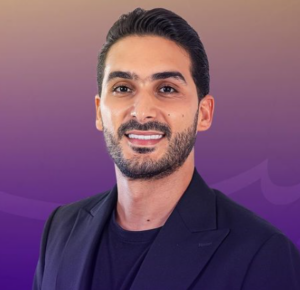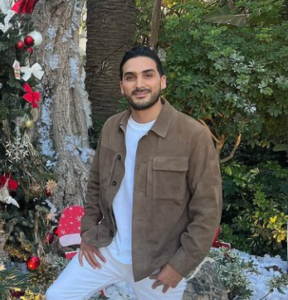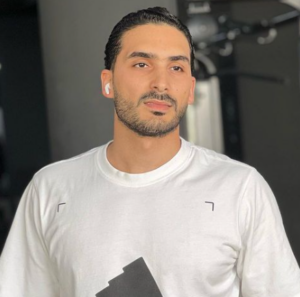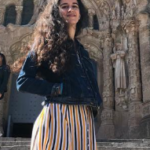Love is Blind: Habibi took a beloved global format and adapted it to the rich and diverse cultures of the Middle East
By encouraging participants to prioritize emotional connection over physical appearance, the show provided a fresh perspective on love and relationships in the region.
The success of couples like Simo and Hajar demonstrated that, despite the challenges, love can truly be blind—transcending cultural, physical, and geographical boundaries.
This groundbreaking show offered a reminder that, in a world often focused on appearances, emotional connection remains one of the most powerful forces in building lasting relationships.
Love is Blind: Habibi left a lasting impression on viewers by proving that love, in all its forms, is universal.

Also Read: Love is Blind UK: Steven and Sabrina Connect Through Their Grandparents and Spa Day
Table of Contents
Love is Blind: Habibi – Unique Twist on a Global Phenomenon
“Love is Blind” has become a worldwide sensation, captivating audiences with its unconventional approach to dating.1
By challenging participants to form deep emotional connections before seeing one another, the show pushes the boundaries of what modern dating typically entails.
In 2024, the show introduced its first Middle Eastern version, Love is Blind: Habibi, bringing the concept to a new cultural context. With a focus on singles from across the Middle East, this edition showcased how individuals from diverse backgrounds embraced the experiment.
As a result, Love is Blind: Habibi offered a refreshing perspective on love, relationships, and cultural dynamics in the region.
The Concept of Love is Blind
At the heart of the Love is Blind franchise is the idea that emotional connections should take precedence over physical appearances. Participants date each other in “pods,” where they cannot see their potential partners.
Instead, they engage in deep conversations, sharing their life stories, values, and aspirations. The goal is for these emotional bonds to become strong enough to lead to a proposal of marriage before the couple meets face-to-face.
Once the proposal is accepted, the couple can finally meet and decide if their physical attraction matches the emotional connection they’ve built.
This novel approach challenges traditional dating norms, which often place heavy emphasis on physical attraction. By stripping away the visual element, Love is Blind encourages participants to prioritize compatibility, communication, and shared values over looks.
Cultural Context in Love is Blind: Habibi
The Middle Eastern version, Love is Blind: Habibi, introduced a unique twist to the format. The region’s rich cultural diversity, ranging from Morocco to Lebanon, created an intriguing backdrop for the show.
Dating practices in the Middle East often emphasize family involvement, religious considerations, and sometimes arranged marriages, making Love is Blind: Habibi a bold experiment in modernizing romance while maintaining respect for cultural values.
For many participants, the experiment was not just about finding a partner but also about navigating cultural expectations. Some entered the pods hoping to meet someone from a similar cultural or religious background, while others were open to exploring connections with individuals from different countries within the region.
This added a fascinating layer to the emotional journey of each couple, as they had to reconcile their personal desires with the traditions and expectations of their home countries.

Simo and Hajar: Standout Connection
One of the most memorable couples from Love is Blind: Habibi was Simo and Hajar. Both Moroccan by heritage, the two instantly bonded in the pods over shared cultural experiences, language, and values.2
Their connection was one of the strongest of the season, as they opened up about their families, dreams, and challenges they had faced. Both felt that their cultural similarities created a strong foundation for their relationship.
When Simo and Hajar finally met in person, their emotions were palpable. Simo, visibly moved, told Hajar, “You’re making me blush,” to which she responded, “Me too.”
This sweet, genuine interaction highlighted the power of the experiment. Both had gone through the process of building an emotional connection without any physical influence, and their first meeting felt like the culmination of a journey that transcended mere appearances.
Their story resonated with viewers because it showcased how Love is Blind: Habibi facilitated deep emotional bonds that may not have been formed in a traditional dating scenario.
It was a powerful reminder that shared values, experiences, and emotional support are often more important than physical attraction.
The Role of Cultural Similarities
- Cultural similarities played a significant role in the connections formed on Love is Blind: Habibi. For Simo and Hajar, their Moroccan heritage allowed them to bond over familiar customs, language, and family dynamics.
- These shared experiences helped them navigate the often-awkward process of getting to know someone without seeing them.
- For participants from countries like Egypt, Saudi Arabia, and Lebanon, these cultural commonalities often provided a comforting foundation for emotional connections in the pods.
- However, cultural differences also played a role in some relationships, as participants learned about each other’s backgrounds and customs.
- In some cases, couples used these differences as a way to broaden their understanding of the region’s diverse cultures, while in other cases, they struggled to reconcile varying expectations.
- This dynamic made Love is Blind: Habibi a more nuanced version of the original show, offering a glimpse into how individuals from the Middle East balance modern romance with cultural traditions.

The Emotional Journey of the Participants
Much like the original Love is Blind series, the emotional journey of the participants was at the core of the show’s appeal. For many, the process of building an emotional connection without any physical cues was challenging but ultimately rewarding.
Participants were forced to open up about their vulnerabilities, hopes, and fears in a way that they might not have in a traditional dating setting.
The isolation of the pods created an environment where people could have deep, uninterrupted conversations, allowing them to focus on emotional compatibility.
This led to moments of intense vulnerability, as participants shared their past heartbreaks, family dynamics, and personal insecurities. For many, the process was cathartic, offering them a new perspective on what they truly wanted in a partner.
Challenges Faced by Participants
While the Love is Blind format encourages emotional connections, it also brings unique challenges. Participants must navigate the uncertainty of not knowing whether their physical attraction will match their emotional connection once they meet in person.
This was particularly evident in Love is Blind: Habibi, where cultural expectations about appearance and family approval often played a significant role in the decision-making process.
Additionally, the transition from the pods to the real world posed challenges for many couples. Once the participants left the controlled environment of the show, they had to face real-life pressures, including meeting each other’s families, navigating cultural or religious differences, and dealing with the expectations of marriage.
This often led to moments of tension, as couples realized that the intensity of their emotional connection in the pods didn’t always translate seamlessly into the outside world.

Also Read: Inside Jasmine’s Journey on Love is Blind UK: Personal Growth and Key Takeaways
How Love is Blind: Habibi Broke Boundaries
Love is Blind: Habibi was a groundbreaking show in many ways. It introduced Middle Eastern audiences to a dating experiment that challenged traditional notions of love and relationships.3
By focusing on emotional compatibility rather than physical appearance, the show provided a fresh take on romance in a region where family and cultural values often play a dominant role in the matchmaking process.
The show also broke boundaries by showcasing a diverse range of participants from different countries and cultural backgrounds. This allowed viewers to see how people from the Middle East approach love and relationships in both traditional and modern ways.
The show’s inclusive approach was a welcome change, as it provided representation for different communities across the region.
The Global Appeal of Love is Blind
One of the reasons Love is Blind has become such a global phenomenon is its universal message: love should be based on emotional connection rather than physical attraction.
This message resonates with people from all walks of life, regardless of cultural or religious background. By adapting the format to different regions, the show has proven that the concept of love transcending appearances is a powerful one that can be applied to various cultural contexts.
In Love is Blind: Habibi, the global appeal of the show was evident as participants embraced the experiment with open hearts.
Whether they were seeking someone from their own cultural background or were open to dating across borders, the participants demonstrated that love is a universal experience, one that can flourish even in the most unconventional settings.

Simo’s Proposal in the Pods
Taking the Next Step
As their conversations progressed, Simo became more certain that Hajar was the one for him. During one of their deeper talks, Simo asked Hajar to be his, a significant step in their journey on Love is Blind: Habibi.
Hajar’s immediate and enthusiastic acceptance was a clear indication that she, too, was ready to take the next step with Simo. Their pod proposal highlighted the show’s unique premise—falling in love without seeing each other—and both Simo and Hajar embraced this experience with open hearts.
Their connection felt guided by fate, as Simo had mentioned earlier. He expressed his belief that everything had led him to this moment with Hajar.
The couple’s mutual excitement was palpable, and they looked forward to moving forward in their relationship, eager to meet each other face-to-face for the first time.
View this post on Instagram
The Face-to-Face Encounter: A Moment of Destiny
When the moment finally arrived for Simo and Hajar to meet in person, the anticipation was high. Throughout the build-up to this meeting, Simo had shared a touching story with his friends about his grandfather.
His grandfather had fallen in love with his grandmother without seeing her, and Simo hoped that his relationship with Hajar would mirror this story of love transcending physical appearance. This connection to his family’s history added a layer of meaning to Simo’s journey on Love is Blind: Habibi.
The first face-to-face encounter between Simo and Hajar was filled with emotion. Simo, true to his earlier feelings, wasted no time in proposing once again, this time in person. He knelt down and asked Hajar to marry him, and her response—an excited “yes” three times—captured the intensity of the moment.
This exchange was a turning point in their relationship, confirming the strength of the bond they had built in the pods.
Shared Heritage: The Moroccan Connection
- One of the key aspects of Simo and Hajar’s relationship was their shared Moroccan heritage.
- Both of them had entered the show with the hope of finding someone they could connect with on a deep emotional level, but neither expected to meet a fellow Moroccan.
- This unexpected commonality added another layer to their connection, making their bond feel even more serendipitous.
- Simo, in particular, expressed his surprise and delight at meeting Hajar, saying that he had never imagined he would meet someone with the same cultural background on Love is Blind: Habibi.
- Their shared heritage brought them even closer, as they could relate to each other’s experiences in ways that others on the show might not have been able to.
- This cultural connection, combined with their emotional vulnerability, laid a strong foundation for their relationship moving forward.
Also Read: Love Is Blind: Jessica Vestal Job, Family Details, Bio, Age, Career And More Explored




